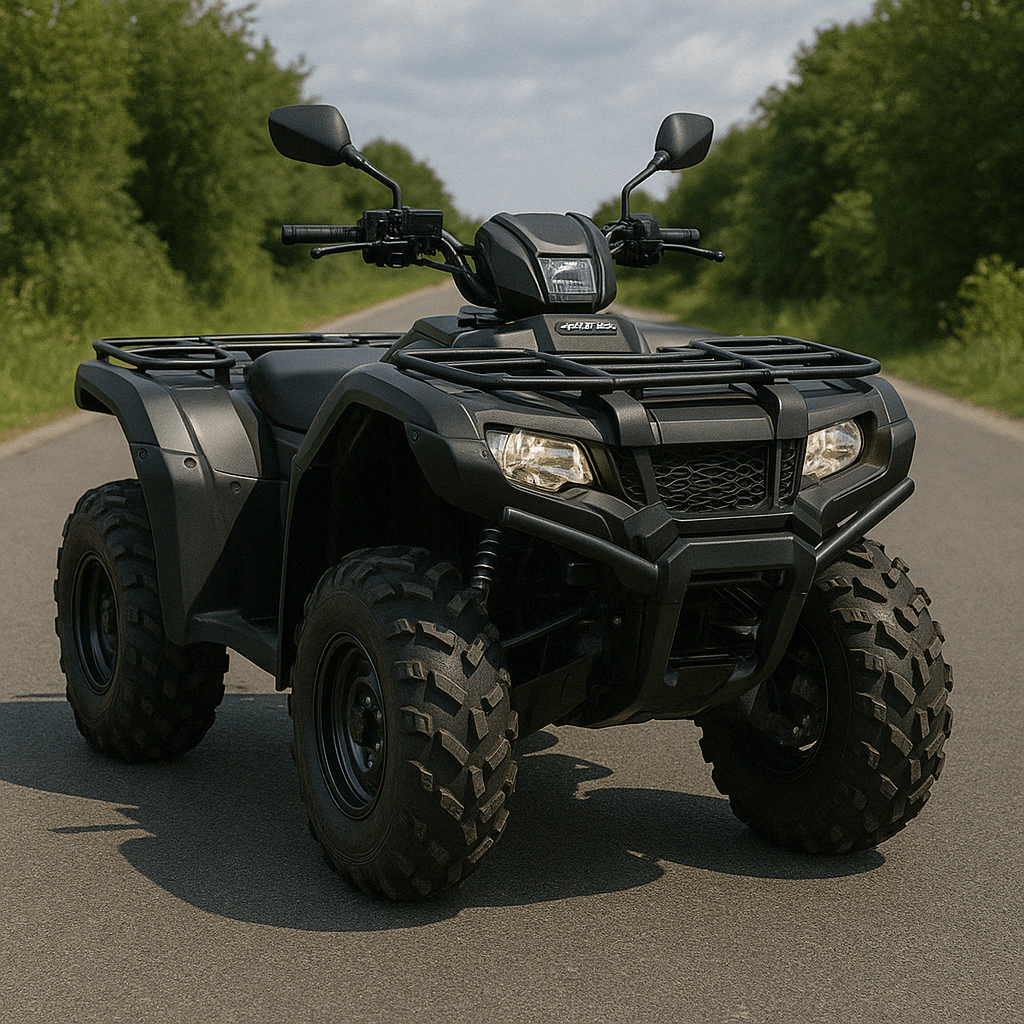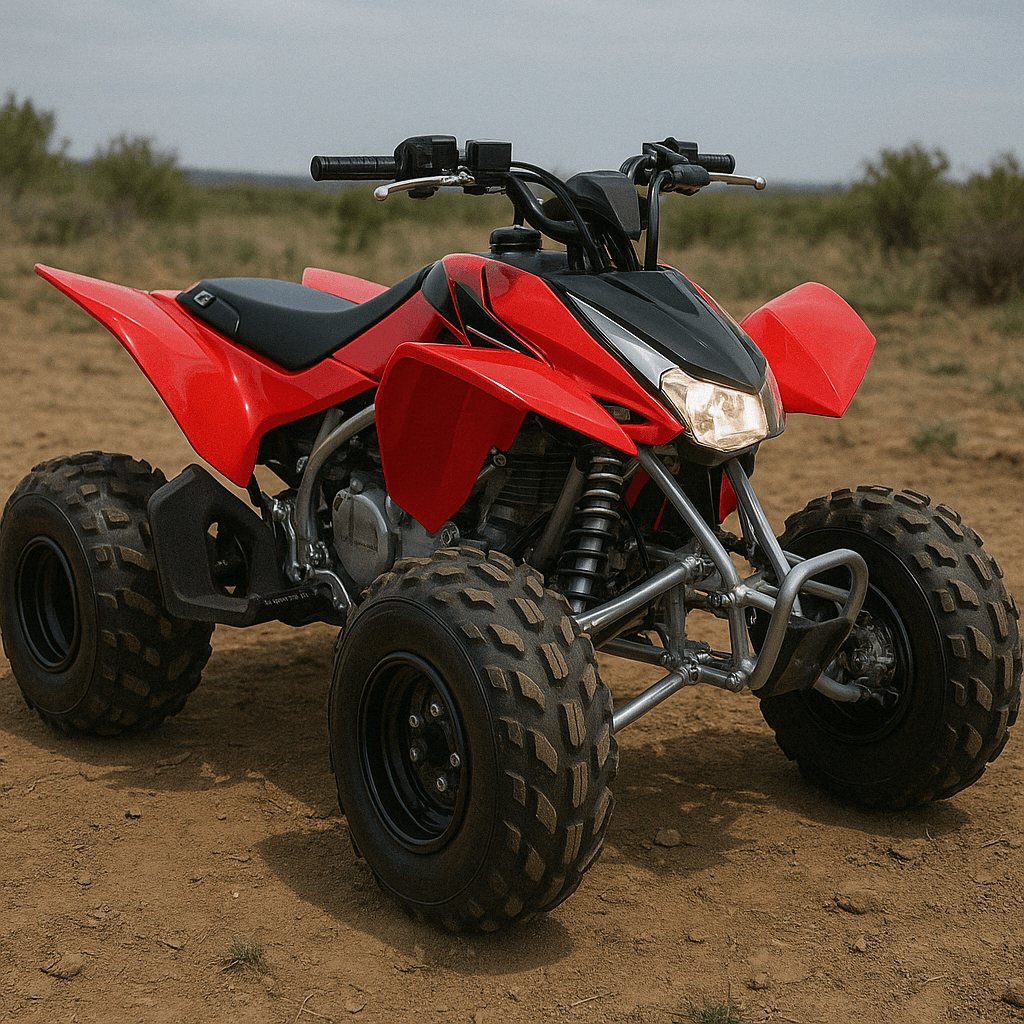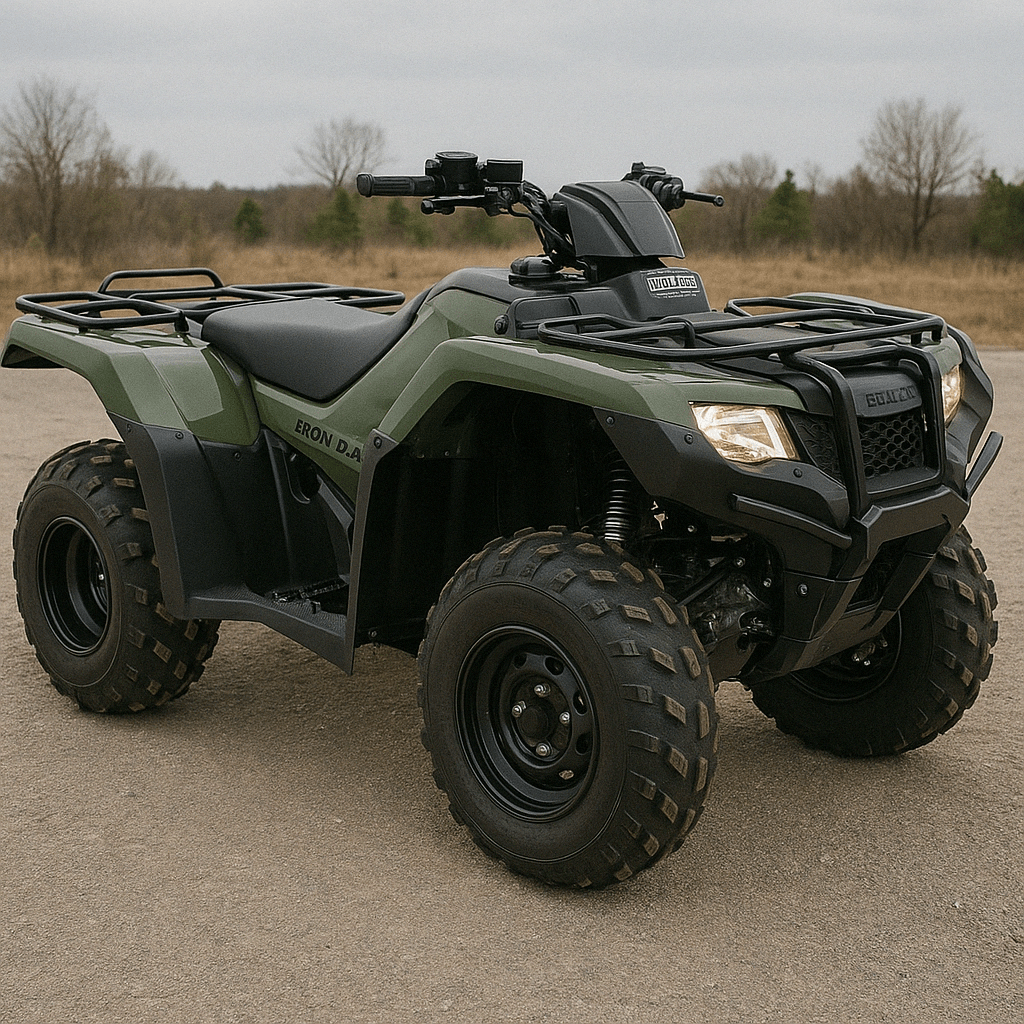Among all-terrain vehicle manufacturers, Honda is a flagship. The automaker’s ATVs consistently rank among the most reliable, durable, and innovative machines. For both sportsmen and work crews, choosing the right ATV isn’t just about power. It’s about investing in a vehicle that demonstrates exceptional performance.
The Evolution of Honda ATVs
Honda ATVs’ journey began with the initiative of Honda engineer Osamu Takeuchi. He successfully revolutionized off-road travel. The introduction of three-wheeled amphibious vehicles was a sensation. Honda broke open the market with its first popular ATV models in the 1970s. At that time, few could have predicted how these machines would transform both recreational riding and utility work applications.

Honda has been widely recognized since the early days of the ATC (All-Terrain Cycle). Today, the carmaker creates sophisticated four-wheel ATV models. The transition from three wheels to four marked a turning point. The distinctive Honda ATC monogram became a symbol of pioneering off-road technology. Today, it’s observed in modern ATVs.
The Honda ATV evolution has been characterized by several advancements:
- Introduction of the Honda trademarked ATC monogram in the early 1970s.
- Development of maintenance-free shaft drive systems in the 1980s.
- Integration of Honda’s electric shifting program, revolutionizing gear changes.
- Implementation of the new Honda automatic transmission options to enhance the rider experience.
- Adoption of innovative longitudinal engine design for improved performance.
- Introduction of telescopic fork front suspension for superior handling.
- Addition of double wishbone front suspension for improved stability.
- Steel hubs replaced with lightweight aluminum components for reduced unsprung weight.
- Enhancement of rear suspension systems for comfort and control.
The rising popularity of ATC racing in the early years helped Honda introduce its refined designs and establish a competitive edge that would carry forward into their four-wheeled models.
Top Honda Utility ATVs
Honda’s utility lineup represents the workhorse side of the ATV world, balancing functionality with reliability. These models have shaped farming, hunting, and industrial applications worldwide. The ATV program at Honda has consistently focused on developing machines that serve both recreational and professional users with equal efficiency.
FourTrax 300 Series
The legendary FourTrax 300 is often cited as the best Honda ATV ever made, establishing itself as the first true utility ATV that transformed how people approached work in difficult terrain. This is the only ground-breaking model that combines simplicity with extraordinary reliability.
- Features engine braking capability for controlled descents.
- Employs a dry sump OHV engine design for consistent performance.
- Includes front and rear racks with substantial carrying capacity.
- Utilizes conventional manual steering for precise control.
- Incorporates a motorcycle-style clutch for experienced riders.
- Showcases durability and engine braking that set industry standards.
Foreman Series
The Foreman series emerged as the definitive high-performance ATV for serious work applications. This powerhouse quickly became the job site leader, building its reputation on toughness and versatility.
- Electric Shift Foreman ES introduced revolutionary push-button electric shifting.
- Longitudinally mounted engine placement provides maximum drivetrain efficiency.
- Tough steel racks support substantial payloads for work applications.
- Wheel disc brakes deliver reliable stopping power.
- Fan-assisted oil cooler prevents overheating during extended operation.
- Designed with automatic clutch options for easier operation.
Rancher Series
The Rancher has earned its place as perhaps the most versatile multipurpose ATV in Honda’s history. This adaptable machine bridges the gap between utility workhorses and recreational trail machines.
- Multiple automatic shifting modes accommodate different riding styles.
- Rancher engine delivers reliable power without excessive fuel consumption.
- Disc brakes front and rear provide consistent stopping power.
- Option for Honda’s electric shift technology or manual transmission.
- Front and rear racks accommodate tools, supplies, or hunting gear.
- Sporty chassis geometry allows for recreational use alongside work applications.
- The innovative five-speed auto shifting system provides smooth transitions on varying terrain.

Top Honda Sport ATVs
While Honda’s utility ATVs built a reputation for reliability, their sport quads ignited passion among thrill-seekers and racers, playing a crucial role in preventing a starving ATV sport industry in the early 2000s.
TRX 250X
The TRX 250X stands as one of the most accessible yet capable sport quads in Honda’s roster. This model has introduced countless riders to the thrill of sport quad riding with its approachable yet exciting platform.
| Feature | Specification |
| Engine | 229cc air-cooled four-stroke |
| Transmission | 5-speed with reverse |
| Suspension | Independent front, swingarm rear |
| Weight | 384 lbs |
| Special Features | Automatic clutch, electric start |
| Ideal For | Beginning sport quad riders, trail enthusiasts |
TRX 400EX
When corporate Honda decided to reenter the recreational market, the 400EX emerged as the serious new sport machine that reignited enthusiasm among riding communities. This model, championed by Honda’s vehicle concept team led by visionaries, became an instant classic.
| Feature | Specification |
| Engine | 397cc air-cooled four-stroke |
| Transmission | 5-speed with manual clutch |
| Suspension | Independent double wishbone front, Pro-Link rear |
| Weight | 405 lbs |
| Special Features | Aluminum wheels, high-performance exhaust |
| Racing Heritage | Baja-proven mill pumped out reliable performance |
TRX 450R
The TRX 450R represents the pinnacle of Honda’s commitment to creating successful sport ATVs. This competition-ready machine, piloted by factory rider Marty Hart among other professionals, collected numerous championships.
| Feature | Specification |
| Engine | 450cc liquid-cooled four-stroke |
| Transmission | 5-speed manual with heavy-duty clutch |
| Suspension | Fully adjustable independent front and rear |
| Weight | 396 lbs |
| Special Features | Triple disc brakes, lightweight aluminum wheels |
| Competition Edge | Premium gear specs, race-tuned power delivery |
Owner Satisfaction and Reliability

The legacy of Honda ATVs isn’t just built on engineering specifications—it’s written in the enthusiastic testimonials of longtime owners. Total ATV sales figures continue to demonstrate Honda’s dominant position in the market, with Honda ATV sales consistently ranking among the industry leaders.
Owner surveys repeatedly highlight several key factors that drive satisfaction with Honda ATVs:
- Exceptional longevity, with many machines exceeding 20+ years of service.
- Minimal downtime for repairs compared to competitor brands.
- Strong resale value retention across most models.
- Consistent performance in extreme conditions.
- Widespread availability of parts and service support.
- Intuitive operation regardless of rider experience level.
While no machine is perfect, Honda ATVs commonly receive praise for their thoughtful design elements and reliability compared to the competition. The dream team Honda assembled to develop these machines clearly understood both the demands of users and the limitations of existing technology.
Choosing the Right Honda ATV for You
Selecting the ideal Honda ATV requires a responsible approach. Assess your primary usage needs, terrain challenges, and personal experience level. No matter whether you’re tackling mud, sand, rocks, or simple trail riding. There’s a Honda model produced for your specific needs.
When evaluating options, consider how you’ll divide time between work and recreation. Many owners find that versatile models like the Rancher or Foreman can serve as excellent best trail riding buddies while still handling property maintenance tasks effectively.
| Model | Ideal Terrain | Primary Use | Experience Level | Key Advantage |
| TRX250X | Moderate trails | Recreation | Beginner | Approachable performance |
| TRX400EX | Advanced trails, dunes | Sport quad riding | Intermediate | Balanced power and handling |
| TRX450R | Competition courses | Racing | Advanced | Hi-performance ATV today |
| Rancher | Mixed terrain | Utility/Recreation | All levels | Versatility |
| Foreman | Rough terrain | Heavy-duty work | Intermediate | Workhorse reliability |
| FourTrax | Basic trails, work sites | Utility | All levels | Simplicity and durability |
Maintenance and Longevity Tips
Honda engineers designed these machines for durability. However, proper maintenance remains essential. The company’s reputation for reliability doesn’t mean these ATVs are maintenance-free. Rather, they reward consistent care with exceptional longevity.
Following Honda’s recommended service intervals is crucial, especially regarding:
- Regular oil and filter changes (typically every 100-200 operating hours).
- Air filter cleaning and replacement schedule based on riding conditions.
- Transmission fluid changes (particularly for electric shifting models).
- Drive chain adjustment and lubrication for relevant models.
- Brake system inspection and maintenance.
- Cooling system maintenance for liquid-cooled models.
- Suspension component lubrication and inspection.
Adhering to these maintenance guidelines helps many Honda ATVs’ owners keep their machines in excellent operating condition. This exceptional durability explains why vintage Honda models often command premium prices in the used market.
FAQs
What is the most reliable Honda ATV model?
The FourTrax 300 is widely considered the benchmark for reliability. Its simple design and robust construction have made it legendary.
- Features minimal electrical components that could potentially fail.
- Uses proven mechanical systems with decades of refinement.
- Employs an engine design prioritizing longevity over maximum power.
- Includes easily serviceable components for DIY maintenance.
How does the FourTrax 300 compare to newer models?
The FourTrax 300 represents old-school reliability. It contains fewer electronics and simpler systems. At the same time, newer models offer enhanced comfort, power, and features. Many Honda enthusiasts appreciate the 300’s straightforward design. However, modern riders often prefer the convenience of current models with electric shifting and automatic transmission options.
Are Honda sport ATVs suitable for beginners?
Honda’s sport quad lineup offers options for distinctive skill levels. Entry-level models, including the TRX250X, feature an automatic clutch. It simplifies operation while providing the excitement of sport quad riding, which makes it a good choice for newcomers.
For absolute beginners, however, utility-focused models with automatic transmissions might provide a gentler learning curve. These machines typically offer more forgiving power delivery and handling characteristics. This helps new riders build confidence before transitioning to more performance-oriented sport quads.
What should I look for when buying a used Honda ATV?
When evaluating a pre-owned Honda ATV, pay attention to some specific factors. Namely, these are the maintenance history and signs of proper care. A well-maintained higher-hour machine often outperforms a neglected low-hour example.
- Check for regular oil changes and filter replacements.
- Inspect chassis components for excessive wear.
- Test all electric shifting functions if equipped.
- Verify cooling system operation.
- Look for unusual noises.
- Confirm proper operation of 4WD systems.
How often should I service my Honda ATV?
Most Honda ATVs benefit from oil changes every 100-200 operating hours. Some models need annual maintenance. Air filters require more frequent attention in dusty conditions. Following the maintenance schedule in your owner’s manual is crucial. Pay particular attention to transmission fluid in electric shifting models. Also, don’t forget to check the differential oil in 4WD units.
Can Honda ATVs handle extreme terrains?
Honda ATVs are constructed to tackle muddy wetlands, rocky mountainsides, and other challenging terrains. The Foreman and Rancher models excel in such rough conditions. This is due to their robust front and rear suspension systems.
For particularly extreme terrain, select the appropriate model with adequate ground clearance and 4WD capability. Honda’s lineup includes specialized machines. They are designed specifically for navigating wet or dry terrain with confidence. Additionally, some aftermarket modifications may enhance performance.
What are the common issues faced by Honda ATV owners?
Honda ATVs are certainly renowned for reliability. Nonetheless, they aren’t without occasional challenges. Being aware of potential issues can help owners address them proactively.
- Electric shifting systems may require more frequent maintenance.
- Some models experience starter motor wear over time.
- Older fuel-injected models can develop injector issues.
- Certain years had plastic components that proved less durable.
- Suspension bushings typically require replacement after extended use.
- In dusty conditions, carburetor-equipped models require frequent cleaning.
Conclusion
Honda is a fine example of an automaker characterized by success in its ATV production. It started with the production of all-terrain vehicles, and now, it’s developing some of the most respected machines in both utility and sport categories. The manufacturer has consistently raised industry standards.
You may be thinking about which Honda ATV can serve your needs. Remember: the perfect choice concerns not only your specific requirements. Your skill level and terrain peculiarities are also essential factors. No matter whether you’re drawn to the raw sport performance of the TRX series or the versatile capability of models like the Rancher. Honda’s legacy of quality ensures you’re investing in more than just a machine. You’re becoming part of an enduring tradition of off-road excellence.

